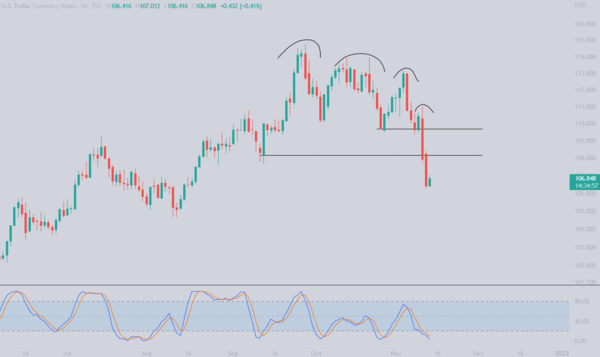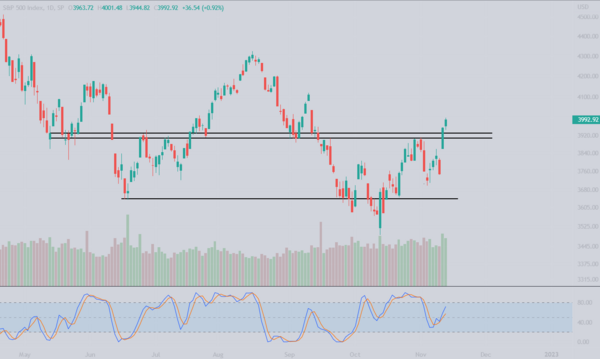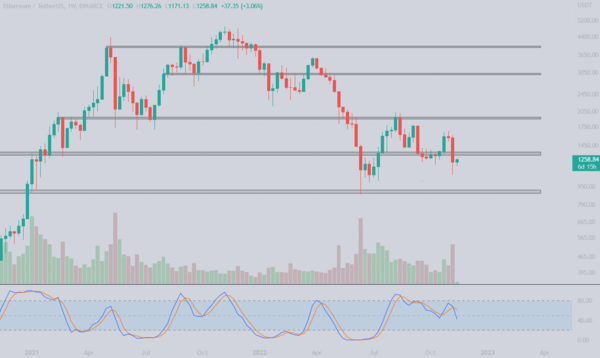
Bloodgang,
Welcome to the fifty-second issue of Bloodgood’s notes. The idea of this newsletter is to give you an overview of the previous week’s fundamentals and what happened on charts as well as to remind you of this week’s articles, secret TA tips, and trading calls. Basically, it’s about giving you all the key info in one place.
Table of contents
- Fundamental overview
- Bitcoin and Ethereum chart
- Blood’s content recap
- Concluding notes
As this community grows, I have a duty to give back to all of you that helped me and supported me to become what I am. This free newsletter is just another way to share my experiences and prepare you for the journey that’s ahead of you.
Love,
Blood
Fundamental overview
Inflation came in at 7.7%, lower than most expectations by 0.2%, but… That’s not on anyone’s mind now, is it?
We had quite the week: if CPI had finally started to show signs of cooling off and DXY looked this bearish at any other point, Bitcoin would probably be above $25k. Now, though, that’s completely overshadowed, and rightly so: the overall levels of insanity recently are unprecedented, even in crypto. As you probably already know, FTX went bust; as I said in the previous newsletter, this was not something I was expecting, but I sincerely hope that you took my advice to move your funds to cold storage, no matter how unlikely it was for something like this to happen. Now that the dust is starting to settle and data about FTX’s balance sheet started to appear, it seems unlikely that those with funds stuck there will get more than 5-10 cents on the dollar.
One reason these events were so insane is that everything was happening more or less in real time on Twitter. After it became clear that FTX was no longer able to operate, Binance sent a Letter of Intent (LOI) to potentially acquire the company, in a move that gave most market participants hope—hope that was soon squashed. Apparently, the hole in the FTX balance sheet was so gigantic that even CZ wouldn’t touch it with a ten foot pole—and if he can’t throw enough money at it to make users whole, then who can? As the bubble of hope in a buyout burst (along with SBF’s entire net worth), harsh reality set in: this mess is too big to be cleaned up by anyone, and the fallout is going to be unbelievably toxic to much more than just Sam’s cabal of amphetamine-fueled “altruists.”
If you’ve been in the space for a while, you’ve seen other exchanges going bust—even one with an incomparably larger market share in the case of Mt. Gox—but this particular blowup still feels different. So many people in crypto thought that FTX was the safest exchange out there, and who can blame them? After all, Sam portrayed himself as close with regulators, while Alameda was widely regarded as incredibly profitable—predatory, maybe, but in any case extremely competent. In the end, just like with Three Arrows Capital, it turned out that things were not as they seemed. The question of how exactly they managed to go under while running a successful exchange, getting super cheap VC allocations, and practically having a whole ecosystem to themselves (Solana), is still open; I’ll mention some possibilities later on, but at this point, everything is still speculation.
Bitcoin

Bitcoin/Dollar Monthly chart

US Dollar Index Daily chart

S&P 500 Daily chart
Bitcoin loses the previous ATH zone that acted as support and eyes key monthly level at $14,000, which was on traders’ radars since we lost $28,000. Although this move down was driven by the FTX crash, we still have to look at charts as they are, and currently they scream bearish. My bids at $14000 are ready, although there is a chance we won’t see them filled due to traditional markets showing signs of strength. People are creating panic on Twitter and due to it, traders are withdrawing their funds from exchanges in huge amounts which could lead to more insolvencies. As I explained before, it’s always a good idea to keep your funds in cold storage, but don’t create panic just to get clout.
As the crypto drama goes on, the S&P 500 is showing strength, breaking above the resistance where it was rejected last week. There is a reason for this break as well, the inflation data came in at 7.7% YoY, which traders considered as bullish as it was finally lower than expected. If this level holds, we should see $4200 tagged soon.
If the S&P 500 is breaking higher, DXY will suffer. The 108 target which we discussed a few weeks ago was reached, and we’re continuing to go lower. I mentioned that DXY did not form a new low previous week, but the CPI data gave more steam to its downtrend.
Ethereum

Ethereum/Dollar Weekly chart

Ethereum/Bitcoin Weekly chart
Ethereum’s move up from a few weeks ago was retraced, again due to the FTX drama, but that means nothing on the charts. When we read charts, we don’t want to be predicting price movements based on assumptions about huge impactful events. Currently the USD pair tells us that the support level at $1350-$1400 was lost, and the weekly candle closed below, which is not a good sign and we should be ready in case ETH decides to revisit the $1000 level. I don’t expect BTC and ETH to keep dumping if SPX pushes higher, though.
The ETH/BTC chart gave us another chance to swap some BTC to ETH, but I bet not many did it or were even thinking about it in the midst of the recent collapse. However, we got another proof that the 0.065 BTC level seems to be interesting for traders. We are back under the resistance that lies around 0.077 BTC, waiting for something to happen. If you are not in a position I do not suggest entering at this point. Either wait for a breakout and buy on the retest, or place bids at the 0.065 BTC level.
Blood’s content recap
Friendly reminder
If you can’t take a daily 100k hit, you don’t deserve a daily 500k gains.
No one has a perfect track record.
One thing is for sure. If you give up, it’s over. If you stick around and believe in yourself there are high chances that you will make it Big.
Crypto Trading Guide Chapter 1 is live on my website
Chapter talks about market cycles, correlation between financial sectors, and the hottest topic at the moment inflation.
Study it and give me your feedback.
The book is finally available for everyone, share it with frens.
Concluding notes
What everyone wants to know is how something as unexpected as the FTX blowup could possibly happen. The first thing to keep in mind here is obviously that, no matter how competent someone seems, you have no idea what’s going on with their balance sheet unless it is public and verifiable. More specifically in this case, I’ve seen speculation going around that Alameda went underwater in May, but was bailed out by FTX in order to prevent Alameda’s giant bag of FTT from being liquidated and tanking the price (apart from the fact that those two entities are, or course, closely connected in different ways). So, FTX was effectively overleveraged and in a very precarious spot for quite some time, but not long enough for the hole in their balance sheet to be patched up. Once CZ decided to attack, they didn’t stand a chance.
This is just speculation, of course, but it seems to make sense. If nothing else, it sure helps explain Sam’s less-than-flattering transformation in recent months, as he was obviously stressed out, shaking and becoming less and less coherent. I’ve seen plenty of insanely big traders blow up, and I can say one thing: when you’re in that kind of mental state all the time, any attempts to make the money back in a few trades will only result in digging the hole even deeper.
What does all this mean for crypto? Unsurprisingly, things aren’t looking too good, primarily because regulators will probably do all the wrong things in response to this crash. It didn’t take long for media publications to start blaming CZ for the whole thing and calling for more regulation of—you guessed it—DeFi. Anyone that knows anything about crypto will know that DeFi is the one place where everything continued working as normal, and events like the one with FTX are impossible, since they hinge on non-transparency. Sure, there are risks—Luna comes to mind here—but anyone can see what the risks are when deciding to invest in or use a DeFi protocol.
To end with a silver lining, there are three positive aspects to this whole situation. First, it’s always better for an overleveraged and shady operation like FTX to crash sooner rather than later; if it’s bad when billions are in play, what would it be like if they had grown to hundreds of billions a couple of years down the line? Second, FTX didn’t hold that much crypto, apart from mostly illiquid Solana-ecosystem stuff, so there’s no gigantic sell pressure like there was with Luna and 3AC. Third, and most important: this should be a lesson for everyone to start taking security more seriously (turns out Bitcoiners had a point when it comes to the importance of cold storage), and for exchanges to become much more transparent. If these lessons are taken seriously by people throughout the industry, this could be a huge step in the maturation of crypto as a whole.




